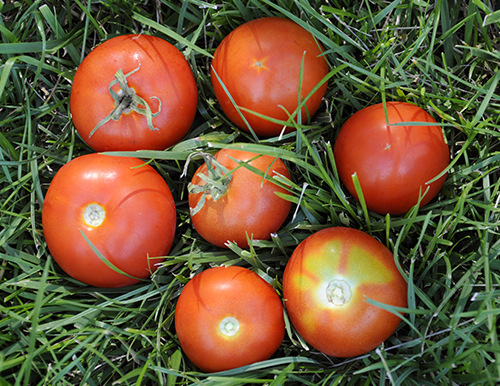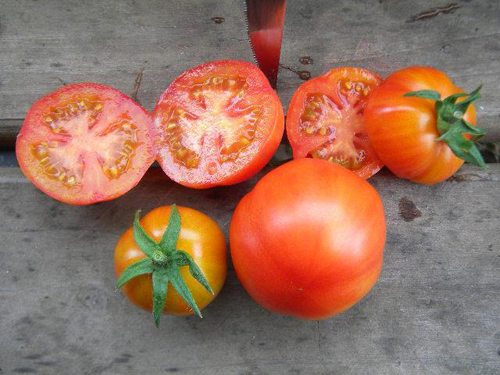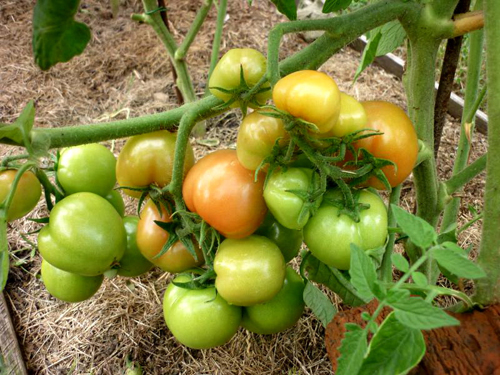Tomato variety Sanka
Various varieties of tomatoes are created annually abroad and in Russia. Each of them has its own peculiarity, some are good for pickling and harvesting, others are grown exclusively for the sake of taste. But there are also universal species suitable for both food and preservation. Therefore, among the many varieties, Sanka was not lost, and is rightfully respected by gardeners. It was bred in the Transnistrian research center for selection, seed production and agricultural technology under the leadership of Yu.I. Pancheva. In 2000, an application was submitted for registration of the novelty. In 2003, the tomato was included in the State Register of Breeding Achievements of Russia in the Central Black Earth District, which includes Belgorod, Voronezh, Kursk, Lipetsk, Orel, Tambov regions. A hardy plant, it is recommended to grow it outdoors. But tomato growers from cool regions successfully grow the plant under film shelters. In addition to Russia, a versatile vegetable is successfully cultivated in Moldova, Belarus, and Ukraine. In fairness, it should be noted that among the many positive reviews there are also dissatisfied ones. Therefore, we will try to present the available information as objectively as possible.

Photo by: Sattarova Naylya, Sverdlovsk region
Description of the variety
The plant belongs to determinant, that is, it independently limits its growth. The bush is undersized, in the open field with a height of 40 - 50 cm, in the closed field it can stretch up to 70 cm, but no more. The stem is powerful, with short internodes. Sanka's shoot-forming ability is good. Sufficient leafiness. Tomato leaves are of normal type, petiolate, medium-sized, green, with moderately pronounced wrinkles. According to the State Register, the inflorescence is of an intermediate type. But the originators point out that the culture has a simple brush that forms 4 - 5 ovaries. The first fruit cluster is laid over the 7th leaf, the next through 1 - 2 leaves. It should be noted that under good weather conditions and proper care, all the ovaries, up to the last brush, manage to form and mature. Therefore, during the harvest season, the bush is simply hung all over with ripe tomatoes. The peduncle is articulated, the place of attachment to the fetus is small.
Tomatoes are attractive in appearance, even, rounded, slightly ribbed. The skin is firm and firm, but not too tough. An unripe tomato is colored green, when ripe it becomes deep red. The pulp is tender, juicy, moderately dense, fleshy, very aromatic. Seed nests - 3 - 4. Taste sweet and sour, according to the State Register, taste is assessed as good. Some gardeners call the taste of Sanka sour. And for gourmets who love fleshy sweet tomatoes, the taste seems to be insufficiently pronounced. In this case, it is necessary to take into account the fact that the described variety refers precisely to early maturing, the purpose of breeding which is not taste, but to provide early production. So, according to the majority, the taste of the variety is quite high when compared with other similar species. Freshly squeezed juice contains 4.5 - 5.6% dry matter, 1.8 - 1.9% total sugar, 0.4 - 0.7% acid. The variety does not belong to large-fruited, and the authors did not set themselves this very task. The mass of tomatoes, according to the State Register, is 71 - 90 grams, the originators claim 80 - 100 grams, the maximum weight is 150 grams. Gardeners engaged in cultivating varieties confirm these data. But as noted, growing conditions have a significant effect on weight.

Characteristics
- Sanka is very early, from the moment of emergence of full shoots to the beginning of ripening, 79 - 85 days pass. But depending on the regions, this period can change up or down. In the southern regions, for example, the first fruits ripen when the ovary is just forming on other varieties.Early maturity allows you to use the culture for re-circulation (the harvest will be already in September), but subject to protection from late blight;
- the yield is excellent. During the testing period, the State Register gives figures of 258 - 348 c / ha, which is 205 c / ha higher than that of the Fitous standard, but at the level of the standard Liang... The maximum yield was shown in the Kursk region - 371 c / ha, which is at the level taken for the Aurora standard (F1). The originators promise 10 kg per 1 square meter. Gardeners also praise the culture for its generosity, reporting 15 kg per sq. meter or 2.5 kg per plant;
- tomatoes ripen together, for the first decade of fruiting, the plant gives off 10 - 34 c / ha;
- the yield of ripe Sanka fruits is high - 77 - 97%;
- high yield of the variety is guaranteed even in low light conditions;
- dense skin prevents cracking of the fruit, even in a period of high humidity;
- ripe tomatoes can stay on the bush for quite a long time, without overripe and without losing their taste and marketability;
- tomatoes taken at the stage of blanche ripeness are perfectly ripened at home;
- the immunity is average, many people note resistance to late blight, although there are other reviews indicating that the culture is one of the first to be exposed to this disease;

- the ability to withstand adverse weather conditions is very high. That is why Sanka grows and bears fruit where more capricious varieties do not show good results;
- the transportability of the fruits is high, due to the elastic structure, the tomatoes do not lose their presentation during transportation;
- in regard to the use of Sanka is really versatile. An early harvest provides vitamin products of our own production, which compensate for the lack of nutrients in the body. The strong skin prevents the tomatoes from cracking in any type of culinary processing, thanks to which the crop is recognized as one of the best for whole-fruit canning. Excellent pulp quality allows you to get excellent tomato products;
- the culture is not a hybrid, therefore, having once bought seeds, in the future you can harvest them yourself, selecting for this the most beautiful of the first ripe tomatoes.
Agrotechnics
It is customary to grow the red-fruited Sanka in central Russia by seedling, but in the southern regions you can sow seeds directly into the ground. Seeds for seedlings are prepared in the usual way, they are sown in containers in late March - early April. After the emergence of full shoots, the container is transferred to a cooler room (temperature about 15 ° C) to prevent the seedlings from pulling out. The pick is carried out in the phase of 2 true leaves. Seedlings are transplanted into the ground when they are 55 - 60 days old. The recommended density is 6 plants per square meter, although the tomato can tolerate more dense plantings - up to 9 bushes for the same area.

In the description of the cultivation of the variety, there are no instructions for tying the plant, but experienced gardeners will definitely put a support next to the bush, since the load on the plant is great, and the stem can bend under the weight of the pouring brushes. But you can really refuse to pinch, but first you should remove all the stepsons to the first fruit brush. It is best to water the bushes with warm water heated in the sun, trying not to get on the leaves and ovaries. In the southern regions, it is advisable to carry out the moisturizing procedure in the evening or early in the morning. During the growing season, at least 3 dressings are carried out. As a fertilizer, you can use universal mineral complexes or organic matter. Planned preventive processing of tomatoes will relieve diseases and pests. And, of course, try to carry out weeding and loosening in time.
Sanka is characterized by many as a reliable and productive variety. It is ideal for outdoor use, which, combined with early maturity, will provide an early harvest even in the absence of a greenhouse. The large productivity and versatility of using tomatoes is highly appreciated by housewives. In terms of care, the tomato is unpretentious, so busy gardeners can safely grow it.Some attentive tomato growers noticed another interesting feature behind the variety - after harvesting, the bush remaining in the garden can again resume growth and the formation of fruit clusters, this period can continue until frost. But negative reviews (which, by the way, are much less than positive) were not without. As a rule, they are all associated with taste and possible damage by late blight.
Sanka golden
Like every successful species, the red-fruited variety has a twin brother called Sanka golden. Its seeds are distributed by several companies - "Demetra - Siberia", "Uralsky Dachnik". The description indicates that the culture has very similar characteristics to its predecessor, except for color and taste. By the way, yellow-fruited tomatoes contain a large amount of carotene, therefore they are very useful for children and the elderly. This novelty does not appear in the State Register, so you can judge its characteristics based on the reviews of tomato growers, which are still very few. So, if we describe the height of the bush, then the plant in the greenhouse does not climb and grows more than 1.5 meters, which casts doubt on its declared determinism. But, perhaps, in the open field, this figure would not differ from the indicated one. The yield is also low, although the fruits show the declared weight. The pulp of this variety tastes sweeter.









Optimal for the Moscow region.
Thanks to this variety, I am always with tomatoes, even if others fail. They ripen gradually, which means that the harvesting period is extended. This season, the last ripe fruits were harvested at the end of September, and the bushes were still strewn with brown and green tomatoes. The bushes are powerful, with a good root system, but flexible and do not break from the wind, it is better to grow seedlings in a greenhouse, and then plant them in open ground. But Sanka also showed himself well in sowing under agrofibre immediately to the beds. Taste qualities are also excellent - moderately acidic, moderately sweet. This is exactly the taste of a real tomato. Suitable for preservation, as they are smooth and with a uniform redness. On a 10-point scale, I give the highest mark.
I love Sanka tomatoes very much, thanks to their unpretentiousness, early, friendly ripening and excellent taste. I plant seeds in early April in open ground, germination is always very good. The bushes are not tall, but spread out, which is why I plant the bushes at a distance of about 45 - 50 cm. The fruits are small, rounded, fragrant and fleshy, with a slight sourness, excellent for conservation. The tomato turns out to be thick, deep red in color.
A variety with peculiarities: it begins to bear fruit with medium-sized tomatoes, which become smaller with each harvest. The crop can be harvested before the first frost. They always delight with a good harvest, the bushes are compact, and the size of the tomatoes is optimal for conservation.
The popular early tomato cannot be found, and it is not just that popular. Begins to bear fruit at 90 - 100 days and continues until the end of the growing season, that is, right up to autumn. In addition, the bushes form undersized, which facilitates the task of caring for them. A huge plus over other varieties is high resistance against late blight.
Very tasty tomatoes, late blight does not take them, so everything ripens on the vine.
This is my favorite tomato variety. Firstly, it is undersized, which simplifies the process of caring for the plant (it does not need to be tied up), and if you are going to grow tomatoes in large areas, then Sanka is an ideal option for this. Secondly, it is early ripe and has time to ripen before late blight begins to rage.You can even not treat it with fungicides, and get environmentally friendly products.
Every year I definitely set aside a place in the country for one of the proven and favorite varieties - Sanka. Since I have to grow seedlings in a city apartment, I am always sure that this tomato will not "stretch" by the time it is planted in the ground; the roots are well developed. It is disease resistant, fruitful, cute and tasty.
I have been using this variety for five years already, and my mother has been this way even longer (she advised them to me). I grow them from seeds on the windowsill and already plant the seedlings in the ground. I fertilize the soil beforehand exclusively with organic matter so that the tomatoes are environmentally friendly. Tomatoes are not very whimsical to care for, since the stems are short and dense and do not need to be tied. Sanka fruits are evenly colored, scarlet, look beautiful in salads with herbs and taste great. They do not burst when pickled, although the rind is not thick. The tomato juice is thick, but not too thick.
I grow a lot of tomatoes - different ripening times, different colors and sizes. From the early Sanka - the most favorite! Although this variety belongs to the early ripening varieties, I do not plant seeds in open ground - in this case, the tomatoes will ripen along with the mid-ripening varieties, so I grow Sanka through seedlings: it does not take up much space - the plants are compact. After planting in open ground, the plants do not cause trouble - they grow together, do not require pinching and pinching, but I recommend tying up the bushes - the variety bears fruit so abundantly that under the load of the harvest the bushes fall and twist the roots. Tomatoes are obtained, as for selection - all of the ideal shape and the same size. This plant has one more advantage - the bushes do not get sick with late blight (only in extremely rare cases when the weather contributes to the disease), since they begin to bear fruit early and manage to give up their entire harvest.
I have been growing Sanka tomatoes for several years. The variety pleased me with the harvest already in the first year of planting and did not fail in the future. The fruit is medium in size and very suitable for canning. But we also use them fresh with pleasure.
The tomato is very unpretentious and does not require too much attention. I tie the bushes without fail, although, in principle, you can do without it. If the summer is dry, I definitely organize watering, in which case the fruits are larger and more juicy. This year I will definitely plant Sanka in my garden.
I think the Sanka variety is the most successful - at least in my region. In our south, during the summer heat, others simply die, and this one simply gives a huge harvest. A small plantation can replace other varieties in terms of yield, even the most famous ones. Smooth fruits, which is good for seaming, excellent taste, and most importantly, early ripening. I have been sowing these tomatoes for a long time and have not yet found a replacement for them. It is resistant to diseases, so I do not process it with anything, because then we will have to eat chemistry ourselves. I plant seedlings in greenhouses in the spring, sow some of the seeds in open ground and get a harvest until the frosts themselves.
Very early, with excellent taste. When the rest of the tomatoes are just thinking of singing, we eat our own tomatoes. It's a pity, a little too small.
And here in Dmitrov, there's no use for Sanka. No fruit at all ...
I have a friend in Dmitrov - only grows it.